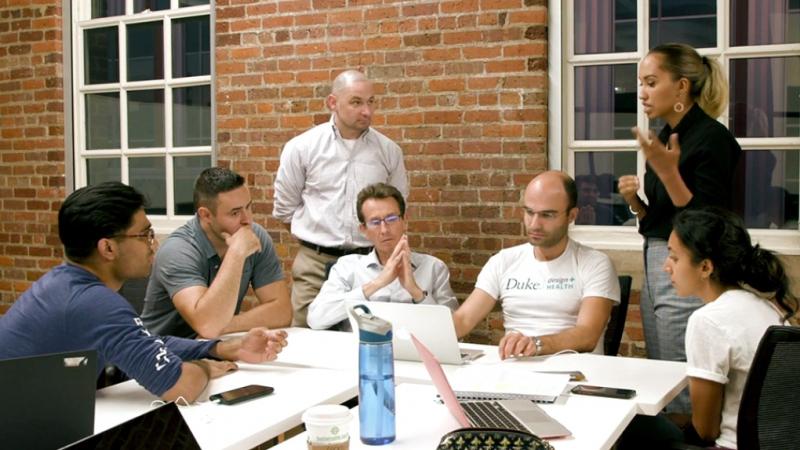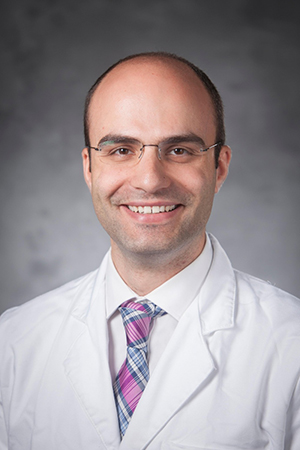
Embedded in the OR
Duke’s Design Health program gives interdisciplinary student teams (like the one pictured above) a new opportunity to create medical solutions
Before and after every surgery, operating room (OR) nurses must complete a count. This involves tallying up every tool in the OR, including scalpels and forceps, soft items like mesh and surgical sponges, towels and other small tools.
The count is a safeguard to prevent the serious––but incredibly rare––possibility of a tool being left inside a patient after surgery. The number from the first count must match the number from the final count, which indicates that all surgical materials are accounted for. If the numbers don’t match, the team of nurses must recount every instrument until the count is correct.
After talking with OR nurses after observing a surgery, Konstantinos Economopoulos, MD, PhD, was surprised to learn that the process can be a significant point of anxiety.
“Some of the nurses told me that there wasn’t a single day when they didn’t have stress with the count,” says Economopoulos, a third-year general surgery resident at Duke University Hospital.
“This anxiety really stood out to me,” he said. “I thought there had to be a way we could help improve this process.”

The ‘we’ Economopoulos refers to are students in Duke University’s Design Health program. Officially launched in August of 2019 after a successful pilot in 2018, the Design Health program teaches participants how to identify pressing needs in health care, and brings together students from the engineering, business, medicine schools and other disciplines across Duke to develop practical and innovative solutions.
“The Design Health program provides a chance for our students to identify and prioritize challenges and create solutions,” says Eric Richardson, PhD, an associate professor of the practice in Duke Biomedical Engineering (BME) and one of the creators of the program. “Beyond building up practical design skills, this program gives our students an opportunity to immerse themselves in a clinical environment and work with stakeholders to identify needs, which is a perspective that isn’t always available in more traditional design programs.”
Helmed by Richardson, Paul Fearis and Joseph A. Knight, Design Health utilizes the diverse backgrounds of its leadership team to better prepare students for careers in industry. Prior to joining Duke, Richardson helped create innovative design programs at Rice University. Paul Fearis, a senior lecturing fellow in Duke BME, spent 28 years in the medical device consulting industry. Knight is an adjunct professor in the Pratt School of Engineering and a faculty member in Duke’s Innovation & Entrepreneurship Initiative, a position that allows him to bring together his experience in both business and medicine.
Students enrolled in Design Health can pursue two roles: a Design Health associate, which is open to students and residents across all schools, or a Design Health fellow, which is open to students and residents in engineering, business or medicine and requires a larger time commitment. As a Design Health fellow, Economopoulos serves as one of the leaders of his design team. This required that he attend a three-week summer ‘bootcamp’ prior to the start of the course, where the fellows worked with Anne-Maria Makhulu, PhD, an associate professor in the department of cultural anthropology, to learn how to make ethnographic observations in their respective areas of interest.

More widely used in anthropology, ethnographic observations allow researchers to observe and interact with their subjects in a real-life environment. In Design Health, this means that students observe healthcare providers in places like the emergency department, ICU, operating room and nurses’ stations.
“By embedding ourselves in the clinical environment, we can see firsthand the work being done and find opportunities where we can ask ourselves how we can make that better,” says Fearis.
“’Better’ might be how we can make procedures faster, how we can reduce risk, or how we can improve outcomes or infection rates,” he says. “Then as engineers and innovators we look at those opportunities and think how we can create technologies or suggest behavioral changes that will help.”
For the ethnographic observations, Economopoulos was paired with another Design Health fellow Jacqueline Vaughn, BSN, RN, and a PhD student and instructor in the School of Nursing.
The duo spent one month observing surgeries in the operating room. There, they took highly detailed and structured notes as they observed day-to-day operations in the OR. First, they noted the people present in the room. Then they would list the tools and materials in the room, following this up with a sketch of the OR to show the locations of both materials and people. The fourth observational step was the most in-depth, requiring fellows to write minute-by-minute notes of what they see.
According to Economopoulos, this step also highlighted the value of partnering with people with different perspectives.
“On June 30th I was a surgical resident who was operating, and on July 1 I was in the OR as an observer, and it was very informative to try and see the same work through different lenses,” he says. “I realized the level of granularity in our notes was also different depending on our knowledge. Jackie Vaughn was focused more on the environment and the interactions and behaviors of the nurses, while I was focused on the actions of the surgeons.”
After three weeks of observations, Vaughn and Economopoulos made a list of 700 opportunities for improvement they had each identified, essentially creating a data set of potential projects. Next they formed two teams, which included design associates Jay Gupta, Shikha Sharma, Michael Lebhar, Kevin Tian, Anshu Jonnalagadda, and Carol Zhou.
“We spent two to three months really trying to hone down which projects were the best ones to pursue,” says Jay Gupta, a biomedical engineering senior and one of the Design Health students on the team. “That involved brainstorming with the team and creating mind maps, but we also relied on feedback from both faculty leaders and from our stakeholders themselves. We’d go back and forth with nurses and doctors, asking them about different challenges and whether they were satisfied with current solutions. It was a highly collaborative process of constant iteration.”
Eventually the team focused on two potential projects: The first involved creating a solution that would improve the surgical-tool counting process; the second focused on creating markers for IV lines to help providers distinguish the lines more easily.
To improve the counting process, the team developed two strategies: one focused on the packaging of tools delivered to the OR and another on using imaging and machine learning technology to automatically identify and count surgical tools and materials.
IV lines can be a source of frustrations for health care workers. A patient in the ICU can be connected to anywhere from six to 18 IV lines providing critical medication. The number of IV lines can make it difficult for patients to get in and out of bed. Nurses and physicians must also be able to immediately identify an IV line to ensure all medications are being administered appropriately.

to promptly identify if there is an issue and fix
it, but this is complicated when they need to
manually trace a line. The new DDHP design
shows how lighting up the line makes it
easier for nurses to check for issues.
The Design Health student team decided to explore how IV lines could more easily be identified. One idea involves adding different colored LEDs to individual wires, which could flash to identify a specific line. They also discussed identifying the lines with a colored system. To prevent the lines becoming tangled, the team explored different IV tube shapes which could be used.
After the student team presented their ideas to the Design Health faculty and the program’s board of advisors, which is made up of faculty from Duke’s schools of engineering, medicine and business, the teams decided to join forces and move forward with the IV line project.
“This was really an area where we could improve patient care and remove some of the burden on nurses and physicians,” says Vaughn.
“The first phase of the program is all about understanding needs, and in the second phase the team is narrowing down the issues to identify what ideas you think are truly viable based on engineering feasibility,” says Shikha Sharma, a PhD student in BME and a Design Associate on the team. “Right now, we’re planning prototypes and in class we’re discussing engineering concepts, and once that’s settled we’ll move onto the business side of things to learn more about marketing our projects.”
At the start of the spring semester, the Design Health teams were prepared to begin creating more concrete design plans and to continue iterating their designs with stakeholders for the IV project. Unfortunately, these plans were stalled due to the evolving pandemic caused by the novel coronavirus.
Figuring out how to collaborate and move in-person design meetings into the virtual world has been yet another challenge that the teams need to address. But according to Richardson the teams are using the opportunity to build communication and technical skills that will be useful in industry jobs where teams are required to work across cities, states and continents.
A few of the Design fellows, including Economopoulos, have also been able to use the observational skills they developed during the first semester of the program to work with Richardson and his team to help identify and develop solutions to ongoing challenges caused by COVID-19. After talking with healthcare workers about their biggest needs during the pandemic, a team from Design Health began 3-D printing medical grade face shields and developed an air-purifying respirator (PAPR) system, which provides more protection than an N95 respirator and face shield.

As of April 2020, the Duke team and their industry partner had printed more than 5,000 completed face masks and 15,000 face frames, which will be distributed to both Duke and the University of North Carolina Health Systems. The PAPR system designs are also available for download on the COVID-19 Engineering Response Team page.
According to Richardson, the goal of the class remains unchanged despite these unprecedented challenges: to get the teams to a place where they can file intellectual property and be on a path to market their ideas. As they prepare to recruit the next class of Design Health students, he’s pleased that the program has continued to attract positive interest from students across Duke.
“In our pilot year we had 12 people, and for the 2019-2020 cohort we recruited 51 people,” says Richardson. “On top of that, we were able to expand our partnerships. The Division of Cardiology in the Department of Medicine was our primary partner in the first year, but now we’ve welcomed The School of Nursing, Department of Surgery and Division of Pulmonology, also in the Department of Medicine
“One of the first ways we’ve been able to measure our success is through the number of students we’ve been able to educate, and we’ve been thrilled with that success so far.”
If you’re interested in participating in the Design Health program, you can submit an application here.
Michaela Kane is a science writer for the Pratt School of Engineering at Duke.
All photos were provided by the Design Health program.
